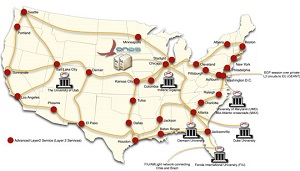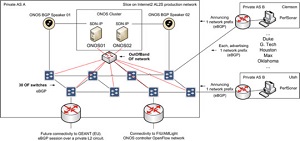News
Internet2 Claims First Big Deployment of Live SDN-based OS
Proof of concepts are popping up all over the young software-defined networking (SDN) landscape, with the latest being the first large-scale deployment of the Open Networking Operating System (ONOS) in a live nationwide network.
That live network is the Internet2 Network, a research and education (R&E) network used for collaborative advanced technology projects.
Internet2 officials worked with Indiana University, which provided its Network Operations Center to connect five higher education institutions: Duke University, Florida International University, the Indiana GigaPoP, MAX and the University of Maryland – College Park, and the University of Utah.
In addition to running ONOS -- a network OS aimed at large, high-scale, high-performance service provider networks -- to connect the schools, the project involved deployment of an SDN-IP Peering application that connects the SDN Internet2 network to other SDN networks or traditional IP-based networks.
"The solution is simple and yet very powerful," Internet2 said in a news release yesterday. "It delivers a migration solution, whereby new SDN capabilities can be deployed alongside existing IP-based networks so that industry adopters can allow the two to coexist while accelerating SDN adoption in real networks. The operators now have a choice to start the SDN deployment in any isolated environment and then leverage an SDN-IP Peering type of application to connect this SDN island to the rest of the network. Following that, they'll be able to apply the SDN technology to the whole network gradually at their own pace."
 [Click on image for larger view.] ONOS on Internet2 (source: Internet2).
[Click on image for larger view.] ONOS on Internet2 (source: Internet2).
The cutting-edge Internet2 network is a high-performance test bed for ONOS, which was recently upgraded in a new release called Cardinal. It can pass traffic at speeds of up to 100 Gbps and features 8.8 Tbps of capacity, serving more than 200 major research schools and 100 nations with advanced broadband connections.
Project officials said that one of the benefits of the Internet2 SDN project was showing how the new-age networking technologies can be used in a real-world environment with heterogeneous hardware components, several participating organizations and a bunch of moving parts.
 [Click on image for larger view.] The Technical Details (source: Internet2).
[Click on image for larger view.] The Technical Details (source: Internet2).
Here are some of the technical details provided by the project:
With this effort, Internet2 is using the capabilities of its SDN substrate to provision virtual networks based on FlowSpace Firewall. An ONOS cluster is deployed in a virtual network slice on the Internet2 network, controlling 38 OpenFlow-enabled Brocade and Juniper switches. The SDN-IP Peering application deployed atop ONOS peers with other, traditional networks. An SDN-based network like Internet2 provides benefits such as network programmability, lower TCO and removal of vendor lock-in. In this particular case, the centralized control plane leads to significant improvements in network operation efficiency for the Internet2 network.
The group said work done early on in the project provided valuable lessons and feedback that will be used to develop further ONOS requirements in future releases. Some advancements have already been made, with the peering app hooking into other ONOS deployments at different universities and global research and education networks such as National R&E Networks around the globe, including European R&E network GEANT/GARR and South American R&E Network AmLight/FIU.
"This is a major milestone in the SDN era," said Internet2 exec Rob Vietzke in a statement. "We are pleased to partner with the ONOS project team to deploy this breakout software-defined capability for the first time on a nationwide production network. This work is a notable contribution by the R&E community in the effort to explore new research ideas in the field of networking and create prototype services that will influence the next generation of the Internet."
That notable contribution joins similar projects designed to prove new-age networking concepts. For example, another ONOS-related project in early May saw the Open Networking Foundation (ONF) and other organizations deploy a peering router between Australia and the United States.
Private industry has been getting involved, also, as just a few weeks later, InterCloud Systems Inc. launched a proof-of-concept lab service where customers can experiment with SDN and network functions virtualization (NFV). And just last Friday, OpenFlow specialist NoviFlow Inc. announced that it proposed an advanced SDN proof-of-concept that was chosen to be implemented by Canada's Centre of Excellence in Next Generation Networks (CENGN).
About the Author
David Ramel is an editor and writer at Converge 360.